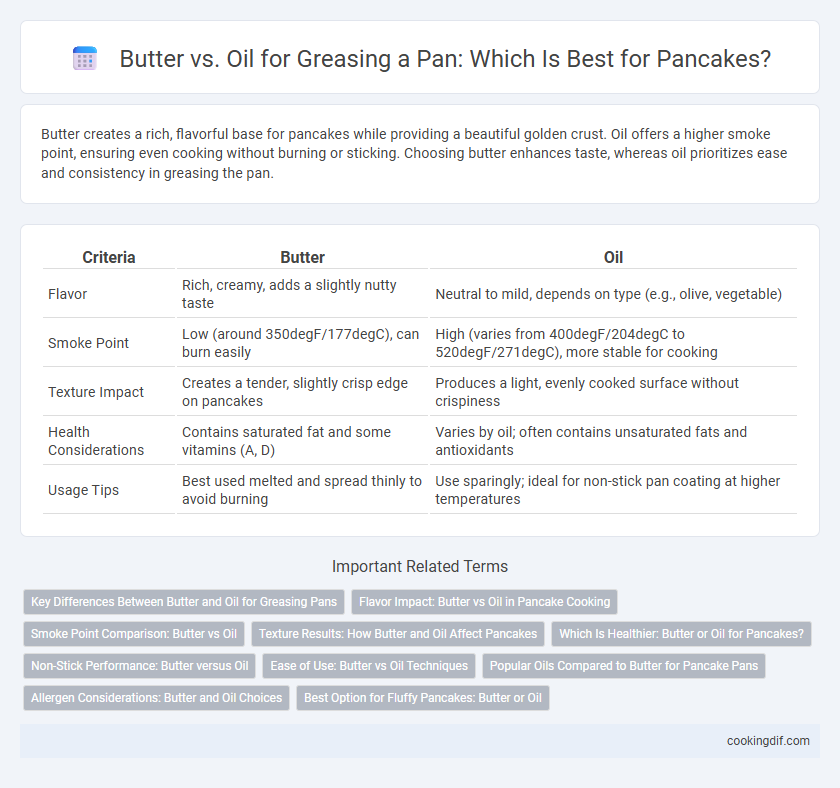Butter creates a rich, flavorful base for pancakes while providing a beautiful golden crust. Oil offers a higher smoke point, ensuring even cooking without burning or sticking. Choosing butter enhances taste, whereas oil prioritizes ease and consistency in greasing the pan.
Table of Comparison
| Criteria | Butter | Oil |
|---|---|---|
| Flavor | Rich, creamy, adds a slightly nutty taste | Neutral to mild, depends on type (e.g., olive, vegetable) |
| Smoke Point | Low (around 350degF/177degC), can burn easily | High (varies from 400degF/204degC to 520degF/271degC), more stable for cooking |
| Texture Impact | Creates a tender, slightly crisp edge on pancakes | Produces a light, evenly cooked surface without crispiness |
| Health Considerations | Contains saturated fat and some vitamins (A, D) | Varies by oil; often contains unsaturated fats and antioxidants |
| Usage Tips | Best used melted and spread thinly to avoid burning | Use sparingly; ideal for non-stick pan coating at higher temperatures |
Key Differences Between Butter and Oil for Greasing Pans
Butter provides a rich flavor and tends to brown more quickly, enhancing pancake flavor but requiring careful temperature control to prevent burning. Oil offers a higher smoke point and creates a non-stick surface with less risk of burning, resulting in evenly cooked pancakes without added flavor interference. Choosing butter or oil depends on desired taste intensity and cooking temperature management during pancake preparation.
Flavor Impact: Butter vs Oil in Pancake Cooking
Butter imparts a rich, creamy flavor to pancakes with a slightly nutty undertone, enhancing their overall taste profile. Oil, especially neutral oils like canola or vegetable, offers a subtle, non-intrusive taste that allows the pancake ingredients to shine without added richness. The choice between butter and oil directly influences the flavor depth and mouthfeel of the final pancake, making butter preferred for a more indulgent taste and oil favored for a lighter, cleaner flavor.
Smoke Point Comparison: Butter vs Oil
Butter has a lower smoke point, approximately 300degF (150degC), which can cause it to burn quickly and impart a bitter flavor during pancake cooking. Oils like canola or vegetable oil boast higher smoke points around 400degF (204degC), allowing for longer cooking without burning and a neutral taste. Choosing oil over butter for greasing the pan reduces smoke and promotes even browning, ideal for perfect pancakes.
Texture Results: How Butter and Oil Affect Pancakes
Butter creates a rich, golden crust on pancakes due to its milk solids that caramelize during cooking, resulting in a slightly crispy exterior and tender interior. Oil provides a more neutral, consistent non-stick surface without adding extra flavor, leading to pancakes with a softer texture and uniform browning. Choosing butter enhances flavor and crispness, while oil ensures even cooking and moisture retention in pancake batter.
Which Is Healthier: Butter or Oil for Pancakes?
Oil, particularly those rich in unsaturated fats like olive or avocado oil, is generally healthier for greasing pans when making pancakes, as it has a higher smoke point and contains heart-healthy fats. Butter, while adding rich flavor, contains saturated fats and can burn more easily, potentially producing harmful compounds when overheated. Choosing oil over butter reduces unhealthy fat intake and minimizes the risk of oxidation and toxic residue during cooking.
Non-Stick Performance: Butter versus Oil
Butter offers moderate non-stick performance due to its milk solids, which can brown and cause sticking at higher temperatures, making it ideal for low to medium heat pancakes. Oil provides superior non-stick properties by remaining stable at higher temperatures without burning, ensuring easy pancake release and uniform browning. Choosing oil, especially vegetable or canola, enhances non-stick effectiveness and preserves the pancake's texture and appearance during cooking.
Ease of Use: Butter vs Oil Techniques
Butter melts quickly and provides a rich flavor but requires careful temperature control to prevent burning when greasing a pan for pancakes. Oil offers a higher smoke point and a smooth, even coating that minimizes sticking, allowing for easier and more consistent pan greasing. Choosing oil often simplifies the process due to its stability and ability to evenly coat the surface without rapid burning.
Popular Oils Compared to Butter for Pancake Pans
Butter offers a rich flavor and helps achieve a golden-brown crust on pancakes, but popular oils such as canola, vegetable, and coconut oil provide a higher smoke point and more even heat distribution, reducing the risk of burning. Coconut oil adds a subtle sweetness and aroma, enhancing the pancake's taste, while canola and vegetable oils contribute a neutral flavor that allows the batter's ingredients to shine. Choosing oil over butter often results in a lighter, crispier texture and easier cleanup, making oils a preferred choice for many pancake enthusiasts.
Allergen Considerations: Butter and Oil Choices
Butter contains dairy proteins, making it unsuitable for those with milk allergies or lactose intolerance, while many oils, such as canola, olive, and coconut, are free from common allergens. Choosing allergen-friendly oil options ensures safe cooking for individuals with dietary restrictions or sensitivities. Coconut oil requires caution for those with tree nut allergies, whereas refined oils generally pose lower allergen risks.
Best Option for Fluffy Pancakes: Butter or Oil
Butter provides rich flavor and helps achieve golden, crispy edges on pancakes, enhancing overall taste and texture. Oil, especially neutral oils like vegetable or canola, promotes even cooking and prevents sticking without altering flavor, contributing to a soft and fluffy interior. For the fluffiest pancakes, lightly greasing the pan with butter is preferred due to its ability to create a delicate crust while keeping the inside tender.
Butter vs oil for greasing pan Infographic

 cookingdif.com
cookingdif.com